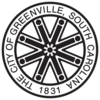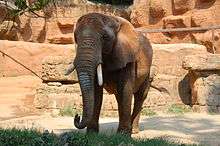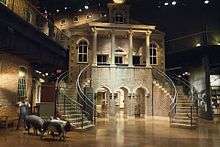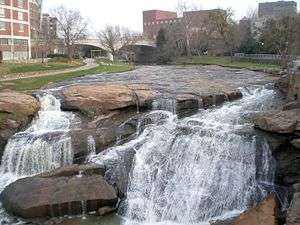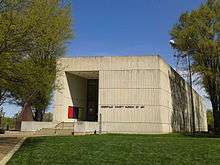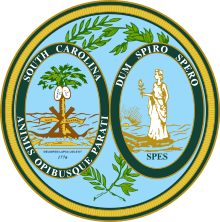Greenville, South Carolina
| Greenville, South Carolina | |||
|---|---|---|---|
| City | |||
| City of Greenville | |||
 Clockwise from top left: Downtown Greenville, Furman University Bell Tower, Falls Park on the Reedy, Reedy River, Peace Center | |||
| |||
 Greenville Location within South Carolina | |||
| Coordinates: 34°50′40″N 82°23′8″W / 34.84444°N 82.38556°WCoordinates: 34°50′40″N 82°23′8″W / 34.84444°N 82.38556°W | |||
| Country |
| ||
| State |
| ||
| County | Greenville | ||
| Incorporated (as a village) | December 17, 1831[1] | ||
| Government | |||
| • Mayor | Knox H. White (R) | ||
| Area | |||
| • City | 28.8 sq mi (74.6 km2) | ||
| • Land | 28.7 sq mi (74.3 km2) | ||
| • Water | 0.2 sq mi (0.4 km2) 0.5% | ||
| • Urban | 320 sq mi (830 km2) | ||
| • Metro | 2,790 sq mi (7,220 km2) | ||
| Elevation | 966 ft (294 m) | ||
| Population (2010) | |||
| • City | 58,409 | ||
| • Estimate (2017) | 68,219 | ||
| • Rank | SC: 6th | ||
| • Density | 2,360.8/sq mi (911.52/km2) | ||
| • Urban | 400,492 (US: 93rd) | ||
| • MSA (2017) | 895,923 (US: 61st) | ||
| • CSA (2017) | 1,459,766 (US: 38th) | ||
| Demonym(s) | Greenvillian | ||
| Time zone | UTC−5 (EST) | ||
| • Summer (DST) | UTC−4 (EDT) | ||
| ZIP codes | 29601-29617 | ||
| Area code | 864 | ||
| FIPS code | 45-30850 | ||
| GNIS feature ID | 1245842[2] | ||
| Interstate Highways |
| ||
| U.S. Highways |
| ||
| Waterways | Reedy River, Enoree River | ||
| Airports | Greenville–Spartanburg International Airport, Greenville Downtown Airport | ||
| Website |
www | ||
Greenville (/ˈɡriːnvɪl/; locally /ˈɡriːnvəl/) is the largest city in and the seat of Greenville County, South Carolina, United States.[3] The city's mayor is Knox White, who has been in that position since December 1995.[4] With an estimated population of 68,219 as of 2017,[5] it is the sixth-largest city in the state. The population of the surrounding area was 400,492 as of 2010,[6] making it the third-largest urban area in South Carolina as well as the fastest growing. Greenville is the largest city in the Greenville-Anderson-Mauldin Metropolitan Statistical Area. The MSA had a population of 895,923 in 2017,[7] making it the largest in South Carolina and the third largest in the Carolinas.
Greenville is the largest city in the Greenville-Spartanburg-Anderson Combined Statistical Area, a 10-county region of northwestern South Carolina known as "The Upstate". According to United States Census Bureau, the CSA had a population of 1,459,766 as of 2017,[8] making it the largest CSA in the state. Greenville is located approximately halfway between Atlanta and Charlotte, North Carolina, along Interstate 85, and its metropolitan area also includes Interstates 185 and 385.
Greenville has gained recognition in various national publications such as CNN Money, which ranked Greenville as one of the "Top 10 Fastest Growing Cities in the U.S." Bloomberg named Greenville the Third Strongest Job Market for 2010; and Forbes named Greenville the 13th Best City for Young Professionals. Greenville also earned the No. 3 slot by Condé Nast Traveler's "Best Small Cities in the U.S." in 2017. Greenville was the fourth fastest-growing city in the United States between 2015 and 2016, according to the U.S. Census Bureau.[9]
History
From Cherokee Land to Greenville County

The land of present-day Greenville was once the hunting ground of the Cherokee, which was forbidden to colonists. A wealthy settler from Virginia named Richard Pearis arrived in South Carolina around 1754 trading with Cherokee. Pearis had a child with a Cherokee woman and received about 100,000 acres (40,000 ha) from the Cherokee around 1770. Pearis established a plantation on the Reedy River called the Great Plains in present-day downtown Greenville. The American Revolution divided the South Carolina country between the Loyalists and Patriots. Pearis supported the Loyalists and together with their allies; the Cherokee attacked the Patriots. The Patriots retaliated by burning down Pearis' plantation and jailing him in Charleston. Pearis never returned to his plantation but Paris Mountain is named after him.[10] The Treaty of Dewitt's Corner in 1777 ceded almost all Cherokee land, including present-day Greenville, to South Carolina.[11]
Greenville County was created in 1786 and was named for its physical appearance. However, other sources say Greenville is named after General Nathanael Greene in honor of his service in the American Revolutionary War.[12][13] Lemuel J. Alston came to Greenville County in 1788 and bought 400 acres (160 ha) and a portion of Pearis' former plantation. In 1797 Alston used his land holdings to establish a village called Pleasantburg where he also built a stately mansion. In 1816, Alston's land was purchased by Vardry McBee, who then leased the Alston mansion for a summer resort, before making mansion his home from 1835 until his death in 1864. Considered to be the father of Greenville, McBee donated land for many structures such as churches, academies, and a cotton mill. Furman University was funded by McBee who helped bring the university to Pleasantburg from Winnsboro, South Carolina in 1851. In 1853 McBee and other Greenville County leaders funded a new railroad called the Greenville and Columbia Railroad. Pleasantburg boomed to around 1,000 in the 1850s due to the growth of McBee's donations and the attraction of the town as a summer resort for visitors.[14][15] In 1831 Pleasantburg was incorporated as Greenville.[16]
Modern Greenville

In December 1860 Greenville supported a convention to debate the issue of secession for South Carolina. The Greenville District sent James Furman, William K. Easley, Perry E. Duncan, William H. Campbell, and James P. Harrison as delegates for the convention. On December 20, 1860 the South Carolina state convention, along with the Greenville delegation, voted to secede from the Union. Greenville County provided over 2,000 soldiers to the Confederate States Army. The town supplied food, clothing, and firearms to the Confederacy. Greenville saw no action from the war until 1865 when Union troops came through the town looking for President Jefferson Davis of the Confederacy who had fled south from Richmond, Virginia. In June 1865 Andrew Johnson appointed Greenville County native Benjamin Franklin Perry as Governor of South Carolina.[14][17]
In February 1869, Greenville's town charter was amended by the S. C. General Assembly establishing Greenville, the town, as a city. Construction boomed in the 1870s such as the establishment of a bridge over the Reedy River, new mills on the river and new railroads. The Greenville News was established in 1874 as Greenville's first daily newspaper. Southern Bell installed the first telephone lines in the city. The most important infrastructure that came to the city were cotton mills. Prominent cotton mill businesses operated near Greenville making it a cotton mill town. By 1915 Greenville became known as the "Textile Center of the South."[14]

During World War I, Greenville served as a training camp center for Army recruits. After World War I commercial activity expanded with new movie theaters and department stores. The Mansion House was demolished and replaced with the Poinsett Hotel in 1925.[14] The Great Depression hurt the economy of Greenville forcing mills to lay off workers. Furman University and the Greenville Women's College also struggled in the crippling economy forcing them to merge in 1933. The Textile Workers Strike of 1934 caused such an uproar in the city and surrounding mill towns that the National Guard had to subdue the chaos. The New Deal established Sirrine Stadium and a new Greenville High School. The Greenville Army Air Base was established in 1942 during World War II contributing to the further growth of Greenville.[14]
The last lynching in the South Carolina occurred in Greenville on February 16, 1947, when Willie Earle, accused of stabbing a cab driver, was taken from his jail cell by a mob and murdered. Thirty-one men were tried and acquitted of the crime.[18]
After World War II Greenville's economy surged with the establishment of new downtown stores and the expansion of the city limits. Furman University doubled its student population and moved to a new location. Higher education facilities such as Bob Jones University in 1947 and Greenville Technical College in 1962 were established in Greenville. The Greenville–Spartanburg International Airport was established in nearby Greer in 1962. The economy of Greenville finally waned in the 1970s leaving a void in downtown Greenville due to the flight of many retailers. Mayor Max Heller revitalized downtown Greenville by establishing the Greenville County Museum of Art and the Hughes Main Library. Main Street was then converted into a two-lane road lined with trees and sidewalks.[19]
Geography
Greenville is located at 34°50′40″N 82°23′8″W / 34.84444°N 82.38556°W (34.844313, −82.385428),[20] roughly equidistant between Atlanta (145 miles [233 km] southwest), and Charlotte, North Carolina (100 miles [160 km] northeast). Columbia, the state capital, is 100 miles (160 km) to the southeast.
Greenville is in the foothills of the Blue Ridge Mountains, a physiographic province of the larger Appalachian Mountains range, and includes many small hills. Sassafras Mountain, the highest point in South Carolina, is in northern Pickens County, less than 40 miles (64 km) northwest of Greenville. Many area television and radio station towers are on Paris Mountain, the second most prominent peak in the area, 8 miles (13 km) north of downtown Greenville. According to the United States Census Bureau, Greenville has a total area of 28.8 square miles (74.6 km2), of which 28.7 square miles (74.3 km2) are land and 0.2 square miles (0.4 km2), or 0.51%, are water.[21] The Reedy River, a tributary of the Saluda River, runs through the center of the city.
Greenville is located in the Brevard Fault Zone and has had occasional earthquakes, though they are minor.
Climate
Greenville, like much of the Piedmont region of the southeastern United States, has a humid subtropical climate (Köppen Cfa), with four distinct seasons; the city is part of USDA Hardiness zone 7b/8a.[22] Winters are short and generally cool, with a January daily average of 42.2 °F (5.7 °C). On average, there are 59 nights per year that drop to or below freezing, and only 1.3 days that fail to rise above freezing.[23] April is the driest month, with an average of 3.36 inches (85 mm) of precipitation.
Summers are hot and humid, with a daily temperature average in July of 79.9 °F (26.6 °C). There are an average 43 days per year with highs at or above 90 °F (32 °C).[23] Official record temperatures range from 107 °F (42 °C) on July 1, 2012, down to −6 °F (−21 °C) on January 30, 1966; the record cold daily maximum is 19 °F (−7 °C) on December 31, 1917, while, conversely, the record warm daily minimum is 80 °F (27 °C) on July 12, 1937, the last of three occasions.[23] The average window for freezing temperatures is November 4 thru April 1, allowing a growing season of 217 days.[23]
Precipitation is generally less frequent in autumn than spring [23] and, on average, Greenville receives 47.2 inches (1,200 mm) of precipitation annually, which is somewhat evenly distributed throughout the year, although summer is slightly wetter; annual precipitation has historically ranged from 31.08 in (789 mm) in 2007 to 72.53 in (1,842 mm) in 1908.[23] In addition, there is an average of 4.7 inches (11.9 cm) of snow, occurring mainly from January thru March, with rare snow occurring in November or April. More frequent ice storms and sleet mixed in with rain occur in the Greenville area; seasonal snowfall has historically ranged from trace amounts as recently as 2011–12 to 21.4 in (54 cm) in 1935–36.[23] These storms can have a major impact on the area, as they often pull tree limbs down on power lines and make driving hazardous.
| Climate data for Greenville, South Carolina (Greenville–Spartanburg Int'l), 1981–2010 normals,[lower-alpha 1] extremes 1884–present[lower-alpha 2] | |||||||||||||
|---|---|---|---|---|---|---|---|---|---|---|---|---|---|
| Month | Jan | Feb | Mar | Apr | May | Jun | Jul | Aug | Sep | Oct | Nov | Dec | Year |
| Record high °F (°C) | 82 (28) |
81 (27) |
91 (33) |
94 (34) |
100 (38) |
105 (41) |
107 (42) |
105 (41) |
101 (38) |
97 (36) |
86 (30) |
79 (26) |
107 (42) |
| Mean maximum °F (°C) | 69.4 (20.8) |
72.5 (22.5) |
80.8 (27.1) |
86.0 (30) |
90.2 (32.3) |
95.1 (35.1) |
97.3 (36.3) |
95.9 (35.5) |
91.1 (32.8) |
84.4 (29.1) |
77.1 (25.1) |
69.5 (20.8) |
98.6 (37) |
| Average high °F (°C) | 52.4 (11.3) |
56.6 (13.7) |
64.5 (18.1) |
72.8 (22.7) |
80.2 (26.8) |
87.5 (30.8) |
90.3 (32.4) |
88.6 (31.4) |
82.2 (27.9) |
72.8 (22.7) |
63.5 (17.5) |
54.1 (12.3) |
72.1 (22.3) |
| Average low °F (°C) | 32.0 (0) |
34.9 (1.6) |
41.2 (5.1) |
48.3 (9.1) |
57.2 (14) |
65.8 (18.8) |
69.4 (20.8) |
68.7 (20.4) |
61.8 (16.6) |
50.4 (10.2) |
41.3 (5.2) |
34.0 (1.1) |
50.4 (10.2) |
| Mean minimum °F (°C) | 14.6 (−9.7) |
19.0 (−7.2) |
24.2 (−4.3) |
32.6 (0.3) |
42.7 (5.9) |
55.0 (12.8) |
61.7 (16.5) |
60.7 (15.9) |
47.9 (8.8) |
34.1 (1.2) |
26.0 (−3.3) |
18.1 (−7.7) |
11.8 (−11.2) |
| Record low °F (°C) | −6 (−21) |
−5 (−21) |
11 (−12) |
22 (−6) |
27 (−3) |
40 (4) |
53 (12) |
50 (10) |
32 (0) |
25 (−4) |
11 (−12) |
3 (−16) |
−6 (−21) |
| Average precipitation inches (mm) | 3.82 (97) |
3.97 (100.8) |
4.52 (114.8) |
3.36 (85.3) |
3.76 (95.5) |
3.80 (96.5) |
4.80 (121.9) |
4.48 (113.8) |
3.43 (87.1) |
3.44 (87.4) |
3.70 (94) |
4.11 (104.4) |
47.19 (1,198.6) |
| Average snowfall inches (cm) | 2.3 (5.8) |
1.0 (2.5) |
0.9 (2.3) |
trace | 0 (0) |
0 (0) |
0 (0) |
0 (0) |
0 (0) |
0 (0) |
0.1 (0.3) |
0.4 (1) |
4.7 (11.9) |
| Average precipitation days (≥ 0.01 in) | 10.2 | 9.2 | 9.6 | 9.0 | 9.7 | 10.4 | 11.7 | 10.4 | 8.1 | 7.2 | 8.9 | 9.8 | 114.2 |
| Average snowy days (≥ 0.1 in) | 1.2 | 0.7 | 0.3 | 0.1 | 0 | 0 | 0 | 0 | 0 | 0 | 0.1 | 0.4 | 2.8 |
| Average relative humidity (%) | 65.8 | 62.6 | 62.1 | 60.7 | 68.5 | 70.5 | 74.0 | 75.6 | 75.8 | 70.9 | 68.2 | 67.7 | 68.5 |
| Mean monthly sunshine hours | 176.6 | 182.7 | 236.2 | 264.7 | 269.2 | 270.8 | 267.8 | 253.9 | 229.2 | 235.2 | 184.3 | 169.4 | 2,740 |
| Percent possible sunshine | 56 | 60 | 64 | 68 | 62 | 62 | 61 | 61 | 62 | 67 | 59 | 55 | 62 |
| Source: NOAA (relative humidity 1962–1990, sun 1961–1990)[23][24][25] | |||||||||||||
Law and government
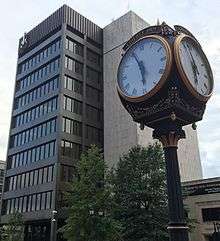
The city of Greenville adopted the Council-Manager form of municipal government in 1976.[26] The Greenville City Council consists of the mayor and six council members. The mayor and two council members are elected at-large while the remaining council members are chosen from single-member districts. Greenville Municipal Court handles criminal misdemeanor violations, traffic violations, and city ordinance violations.[27]
The Greenville Police Department was established in 1845 as the Greenville Police Force. By 1876 the Greenville Police Force became the Greenville Police Department. In 1976 the Greenville Police Department moved into the Greenville County Law Enforcement Center with the Greenville County Sheriff's Department. The Greenville Police Department serves Greenville with around 241 employees with 199 sworn officers.[28]
Attractions
As the largest city in the Upstate, Greenville offers many activities and attractions. Greenville's theaters and event venues regularly host major concerts and touring theater companies. Four independent theaters present several plays a year.
Event venues
- Bon Secours Wellness Arena, the home of the Greenville Swamp Rabbits of the ECHL, is a 16,000-seat arena in downtown Greenville that opened in 1998 as the Bi-Lo Center.[29]
- Peace Center, a performing arts center that includes a concert hall with 2,100 seats and a theater seating 400.[30]
- Timmons Arena, a 5,000 seat multi-purpose venue on the campus of Furman University.[31]
- Fluor Field at the West End, home of the Greenville Drive baseball team, the Class-A affiliate of the Boston Red Sox. The stadium was designed to echo many of the features of Fenway Park, home of the parent club, including a representation of Fenway's Green Monster standing 30 feet (9.1 m) high in left field.[32]
- TD Convention Center, a 280,000-square-foot (26,000 m2) convention and meeting facility that was established in 1964 as the newest of a series of Textile Halls, the original dating back to 1915 as the Southern Textile Exposition[33]
Landmarks
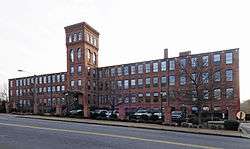
- Falls Park on the Reedy, a large regional park in the West End with gardens and several waterfalls, with access to the Swamp Rabbit Trail. Dedicated in 2004, the $15.0 million park is home to the Liberty Bridge, a pedestrian suspension bridge overlooking the Reedy River. The park's development sparked a $75 million public-private development, Riverplace, directly across Main Street. Falls Park has been called the birthplace of Greenville, but in the mid-20th century the area was in severe decline, and the Camperdown Bridge had been built across the Falls, obstructing view. In the mid-1980s, the City adopted a master plan for the park, leading to the removal of the Camperdown Bridge and making way for extensive renovations, to include 20 acres (81,000 m2) of gardens and the Liberty Bridge. While bridges with similar structural concepts have been built in Europe, the Liberty Bridge is unique in its geometry.
- Greenville County Museum of Art specializing in American art, frequently with a Southern perspective that dates back to the 18th century. It is noted for its collections of work by Andrew Wyeth and Jasper Johns, as well as a contemporary collection that features such notables as Andy Warhol, Georgia O'Keeffe, and others.
- Roper Mountain Science Center is home to a historic 23" refractor telescope, eighth largest of its kind in the United States.[34]
- Greenville Zoo was established in 1960 and is located in Cleveland Park.[35]
Festivals
- Euphoria Greenville is an annual three-day culinary event held in the Wyche Pavilion at Larkin's on the River, Art in the Park, and the Peace Center for the Performing Arts.[36]
- Fall for Greenville is a three-day music and food street festival held each fall.[37]
- Artisphere is a three-day art festival held each spring.[38]
- iMAGINE Upstate is a weeklong celebration and showcase of STEM, entrepreneurial, creative, and innovative activity in the Upstate held each spring.[39]
- Big Fandom Greenville is a three-day comic book and science fiction convention held each October.[40]
- SC Comicon is a two-day comic book convention held annually.[41]
- Indie Craft Parade is a festival of handmade art held each September.[42]
- The Upstate Shakespeare Festival performs Shakespeare and other classic plays each summer in Falls Park.[43]
- The Greek Festival a three-day festival put on by the Greek Orthodox Church in downtown Greenville to celebrate Greek culture.
- New South Comedy Festival is a four-day comedy festival featuring improvisational, stand-up, sketch, and musical comedy from around the country.[44]
Education

Public schools
The Greenville County School District is the largest school district in the state of South Carolina and ranked the 49th largest district in the United States, with 14 high schools, 18 middle schools, and 50 elementary schools in the district.[45][46] With a 2012 budget of $426 million, the district employs 5,200 teachers, 63.1% of which hold a master's degree or higher.[47] In addition to traditional public schools, Greenville's downtown area is home to the South Carolina Governor's School for the Arts & Humanities, a boarding school for young artists.
Private schools
In addition to public schools, Greenville County has a number of private and religious schools, including St Mary's Catholic School (founded in 1900), Camperdown Academy (for students with learning disabilities),[48] Hidden Treasure Christian School (a school for students with physical and/or mental disabilities), Christ Church Episcopal School (a college-preparatory Episcopalian school with an American school outside of Germany certified by the Bavarian Ministry of Education),[49] Shannon Forest Christian School (an evangelical Christian school),[50] Saint Joseph's Catholic School, Our Lady of the Rosary Catholic School, St. Anthony's Catholic School, Southside Christian School (established in 1967 by Southside Baptist Church), Hampton Park Christian School,[51] and Bob Jones Academy and Elementary School and Greenville Classical Academy (a classical Christian school established in 2004).[52]
Colleges and universities

Greenville has several colleges and universities that first began with Furman University. Furman began as Furman Academy and Theological Institution in 1825 named after Richard Furman. The theological school of Furman broke away in 1858 and became Southern Baptist Theological Seminary now in Louisville, Kentucky.[53] North Greenville University was established in 1893 and is affiliated with the South Carolina Baptist Convention.[54] Bob Jones University was established in 1927 by Bob Jones Sr. as a private non-denominational Protestant university.[55] Greenville Technical College was established in 1962 as a technical college. Clemson University has a campus in Greenville called Clemson University International Center for Automotive Research that focuses on automotive research.[56] The University of South Carolina School of Medicine Greenville is a four-year medical school operating on the campus of the Greenville Health System.[57]
Economy
Greenville's economy was formerly based largely on textile manufacturing, and the city was long known as "The Textile Capital of the World". In the last few decades, favorable wages and tax benefits have lured foreign companies to invest heavily in the area. The city is the North American headquarters for Michelin, AVX Corporation, Ameco, Southern Tide, Confluence Outdoor, Concentrix, JTEKT, Hubbell Lighting subsidiary of Hubbell Incorporated, and Scansource. In 2003, the International Center for Automotive Research was created, establishing CUICAR as the new model for automotive research. The Center for Emerging Technologies in mobility and energy was opened in 2011, hosting a number of companies in leading edge R&D and the headquarters for Sage Automotive.
When the former Donaldson Air Force Base closed, the land became the South Carolina Technology and Aviation Center, and became home to a Lockheed Martin aircraft and logistics center, as well as facilities operated by 3M and Honeywell. Donaldson Center Airport now occupies the former air base as a public airport. General Electric has a gas turbine, aviation and wind energy manufacturing operations located in Greenville.
Infrastructure
Health systems
Greenville has two main health systems, the Bon Secours St. Francis Health System and the Greenville Health System.
Bon Secours St. Francis Health System, which includes St. Francis Downtown; St. Francis Eastside; and St. Francis Outpatient Center and Upstate Surgery Center, is ranked among the best hospitals in the nation by HealthGrades for heart surgery and overall orthopedic services.
The Greenville Health System (formerly known as Greenville Hospital System) is a not-for-profit academic medical center that includes seven campuses: Greenville Memorial Medical Center, North Greenville Long Term Acute Care Hospital and ER, Hillcrest Hospital, Patewood Memorial Hospital, Greer Memorial Hospital, Laurens County Memorial Hospital, and Oconee Memorial Hospital. It is one of the largest employers in the region. It was recognized for 2010–2011 as a top provider of cardiac and gastroenterology care by U.S. News & World Report. GHS has the only children's hospital in the Upstate region of South Carolina. It hosts the University of South Carolina School of Medicine Greenville, a full four-year branch of the medical school in Columbia, SC.
Greenville's Shriners Hospital for Children treats pediatric orthopedic patients exclusively, free of charge.
Transportation
Greenville is located on the Interstate 85 corridor, approximately halfway between Atlanta and Charlotte. The northern terminus of Interstate 385 is located downtown, and the area is also served by Interstate 185 and U.S. Highway 123 (Calhoun Memorial Highway). Other major highways include U.S. 25, U.S. 29 and U.S. 276.
There are several airports servicing the Greenville area. The largest in the region, Greenville-Spartanburg International Airport (GSP), is the second busiest in the state and is served by most major airlines. SCTAC (formerly Donaldson Air Base) has undergone significant moderization and is the site of the new South Carolina Army National Guard Aviation Support Facility (AASF) and proposed Super General Aviation Center. Greenville serves as a freight hub for FedEx Express. The Greenville Downtown Airport, is the busiest general aviation airport in South Carolina with nearly 80,000 take-offs and landings annually and more than 245 based aircraft.[58]
Public transit in Greenville is handled by the Greenville Transit Authority (GTA), which contracted out operations to the City Of Greenville in 2008 under a tri-party agreement with Greenville County. The city rebranded the service with the name Greenlink. Greenlink runs a bus system that serves the Greenville area, much of Greenville County including Mauldin and Simpsonville, and a portion of Pickens County via a connector to Clemson.
Greenville has an Amtrak station, which is part of Amtrak's Crescent, connecting Greenville with the cities of New York, Philadelphia, Baltimore, Washington, Charlotte, Atlanta, Birmingham and New Orleans. Additionally, Greenville is included in the proposed Southeast High Speed Rail Corridor, which will run from Washington, D.C. to Birmingham, Alabama. Freight railroad service is provided by CSX Transportation, Norfolk Southern Railway, and the Carolina Piedmont Railroad. The former Greenville and Northern Railway line to Travelers Rest has been abandoned and converted into a hiking and biking trail called the Swamp Rabbit Trail.
Interstates
Interstate 85 runs by Greenville going through Interstate 185 (Greenville) and Interstate 385. Interstate 385 ends in downtown Greenville and connects with Interstate 26. Interstate 185 connects Interstate 385 to Interstate 85 south of Greenville.
Sports teams

Minor League sports teams:
- Greenville Drive, a single A affiliate of the Boston Red Sox in the South Atlantic League. The Drive started their first season in their new downtown ballpark on April 6, 2006, which, prior to the start of the 2008 season, was renamed Fluor Field at the West End. For a short time after their founding, they were called the Greenville Bombers.
- Greenville Swamp Rabbits, a minor league hockey team in the ECHL. Began play in the 2010–11 hockey season as the Greenville Road Warriors and were renamed in 2015.
- Greenville Triumph SC is a soccer team in USL League One that plans to begin play in 2019.
- The Furman Paladins. Furman competes at the NCAA Division I level. (Note: Furman football is a member of the NCAA Football Championship Subdivision.) Furman athletic teams compete on-campus in various venues, including Paladin Stadium, Timmons Arena, and the Eugene Stone Soccer Stadium. Furman is a member of the Southern Conference.
- Bob Jones University competes at the NCCAA Division I level. The BJU Bruins began intercollegiate athletics in the 2012–2013 school year. The school began with men and women's soccer and basketball, and hopes to eventually add other sports.[59] Cross country and golf are to be added for the 2013–2014 school year.
Culture
Greenville has been named one of the "Top 100 Arts Small Towns in the United States." [60] The Bon Secours Wellness Arena brings national tours of many popular bands to downtown, and the Peace Center for the Performing Arts provides a venue for orchestras and plays. A planned multimillion-dollar renovation to the center's main concert hall lobby and riverside amphitheatre began in the spring of 2011.
Visual art

A number of local artists operate studios and galleries in the city, especially the Village of West Greenville near downtown. The Metropolitan Arts Council and Upstate Visual Arts provide a number of public events that focus on the visual arts, including the First Fridays Art Walk, Greenville Open Studios, and the West Greenville Arts Festival. Greenville also provides some notable fine arts museums:
- The Greenville County Museum of Art, home of the Andrew Wyeth Collection, was founded with a significant contribution from local industrialist, Arthur Magill.[61] It contains pieces by Jackson Pollock, Jonathan Greene, Georgia O'Keeffe, Jasper Johns and William H. Johnson.
- The Bob Jones University Museum and Gallery contains a diverse collection of European masterworks[62]
- The future of Greenville is presented visually in The Ecotopia 2121 Project (see: Ecotopia 2121 a book published by Arcade Publishers).[63]
Music
Greenville's music scene features live performances by local jazz, country, and rock bands.
Lynyrd Skynyrd played their last concert with all original members in Greenville, on October 19, 1977.[64][65]
The city is home to the Greenville Symphony Orchestra, Greenville County Youth Orchestra, Carolina Youth Symphony, and the Carolina Pops Orchestra. The Boston Symphony Orchestra regularly performs at the Bon Secours Wellness Arena. Greenville Light Opera Works (GLOW Lyric Theatre) is a professional lyric theatre in Greenville that produces Musical Theatre, Operetta and Opera.
The Palmetto Statesmen Barbershop Chorus and Quartets perform barbershop harmony and a cappella singing at various locations throughout the Upstate.[66] The Palmetto Statesmen Chorus is a member of the Barbershop Harmony Society.
Formed in 1993 by Greenville native Karl Sanders, ancient Egyptian-themed technical death metal band Nile is based in the city.
Comedy
There are eight comedy venues in Greenville featuring stand up comedy, sketch comedy, ventriloquists, as well as experimental and non-traditional comedy.[67]
Dance and theater
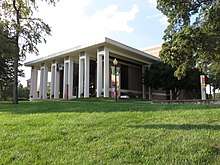
The Carolina Ballet Theatre is a professional dance company which regularly presents programs at the Peace Center and elsewhere. CBT presents four performances annually as the resident professional dance company of the Peace Center with their largest as the holiday classic, "The Nutcracker, Once Upon A Time in Greenville." This production is modelled after the major companies who have set their holiday class in their hometown. Centre Stage, Greenville Little Theater, South Carolina Children's Theater and the Warehouse Theatre are the major playhouses in the area. These theaters offer a variety of performances including well-known works, such as Death of a Salesman and Grease, and plays written by local playwrights. During the Spring and Summer, the local Shakespearean company performs Shakespeare in the Park at the Falls Park Amphitheater.
Media

- The Greenville News is the city's daily newspaper and also the Upstate's largest daily newspaper in circulation and readership.
- Greenville Journal: Weekly newspaper dealing with business, economic development, local events, and current issues relevant to Greenville. It was originally the Greenville Civic and Commercial Journal[68]
- Business Black Box[69] is the Upstate South Carolina's Premier Business Magazine, and the ultimate resource to connect, advise and grow local businesses.
- Upstate Business Journal: Weekly business newspaper reaching 100,000 business leaders in Greenville, Spartanburg, and Anderson counties.
- GSA Business: Published every two weeks, it covers business news from across the Greenville-Spartanburg-Anderson metro area.
- Greenville Business Magazine: Monthly magazine that contains business information for and about the Greenville area.
- Upstate Link magazine: The weekly publication began in January 2004. Link continues to be a print publication, but its website ceased operation in 2008. Its new Web site is run by Chicago-based Metromix.
- Greenville HD: An all-video website that gives viewers a look at everything in Greenville.
Television
Greenville is part of the Greenville-Spartanburg-Anderson-Asheville DMA, which is the nation's 36th largest television market. See the box below for the local television stations:
Radio
Greenville is part of the Greenville-Spartanburg-Anderson Arbitron Metro which is the nation's 59th largest radio market with a person 12+ population of 813,700. See the box below for the local radio stations:
Demographics
| Historical population | |||
|---|---|---|---|
| Census | Pop. | %± | |
| 1850 | 1,305 | — | |
| 1860 | 1,518 | 16.3% | |
| 1870 | 2,757 | 81.6% | |
| 1880 | 6,160 | 123.4% | |
| 1890 | 8,607 | 39.7% | |
| 1900 | 11,860 | 37.8% | |
| 1910 | 15,741 | 32.7% | |
| 1920 | 23,127 | 46.9% | |
| 1930 | 29,154 | 26.1% | |
| 1940 | 34,734 | 19.1% | |
| 1950 | 58,161 | 67.4% | |
| 1960 | 66,188 | 13.8% | |
| 1970 | 61,208 | −7.5% | |
| 1980 | 58,242 | −4.8% | |
| 1990 | 58,282 | 0.1% | |
| 2000 | 56,002 | −3.9% | |
| 2010 | 58,409 | 4.3% | |
| Est. 2017 | 68,219 | [70] | 16.8% |
| Census Bureau Estimate[71] 2016 Estimate[5] | |||
Greenville is the largest principal city of the Greenville-Anderson-Mauldin Metropolitan Statistical Area, a metropolitan area that covers Greenville, Laurens, Anderson and Pickens counties and had a combined population of 874,869 as of 2015.[7]
Since South Carolina law makes annexing the suburban areas around cities difficult, Greenville's city proper population is small as a proportion of the total population of the urbanized area.
As of the census[26] of 2010, there were 58,409 people, 24,382 households, and 12,581 families residing in the city. The population density was 2,148.0 inhabitants per square mile (829.3/km2). There were 27,295 housing units at an average density of 1,046.9 per square mile (404.2/km2). The racial composition of the city was 62.12% White, 31.54% Black or African American, 3.44% Hispanic or Latino (of any race), 1.27% Asian, 0.14% Native American, 0.06% Pacific Islander, 1.37% of other races, and 1.11% of Two or more races.
There were 29,418 households out of which 22.3% had children under the age of 18 living with them, 32.7% were married couples living together, 15.5% had a female householder with no husband present, and 48.4% were non-families. 40.8% of all households were made up of individuals and 12.8% had someone living alone who was 65 years of age or older. The average household size was 2.11 and the average family size was 2.90.
In the city, the age distribution of the population shows 20.0% under the age of 18, 13.8% from 18 to 24, 31.3% from 25 to 44, 20.5% from 45 to 64, and 14.4% who were 65 years of age or older. The median age was 35 years. For every 100 females, there were 89.9 males. For every 100 females age 18 and over, there were 86.8 males.
The median income for a household in the city was $33,144, and the median income for a family was $44,125. Males had a median income of $35,111 versus $25,339 for females. The per capita income for the city was $23,242. About 12.2% of families and 16.1% of the population were below the poverty line, including 22.7% of those under age 18 and 17.5% of those age 65 or over.
| Racial composition | 2000 | 2010 | 2017[72] |
|---|---|---|---|
| White | 62.1% | 64.0% | 67.8% |
| Black | 34.0% | 30.0% | 27.1% |
| Asian | 1.3% | 1.4% | 2.1% |
| Native American | 0.14% | 0.3% | 0.3% |
| Native Hawaiian and other Pacific Islander | 0.06% | 0.1% | 0.1% |
| Two or more races | 1.1% | 1.8% | 1.5% |
| Other | 1.3% | 2.4% | 1.1% |
Neighborhoods
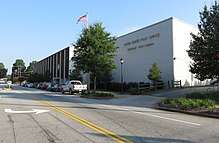
Neighborhoods within the city of Greenville include:
- Alta Vista
- Augusta Road
- Berea
- East Park
- Gower Estates
- Hampton Pinckney
- Heritage
- Nicholtown
- North Main
- Overbrook
- Parkins Mill
- St. Mark
- Sans Souci
- Shoals Crossing
- West End
- West Greenville
Notable people
- Shoeless Joe Jackson, Major League Baseball player
- Jaimie Alexander, actress
- Dorothy Allison, writer
- Cat Anderson, jazz trumpeter (1916-1981) [73]
- Major Rudolf Anderson Jr., the only person killed by enemy fire during the Cuban Missile Crisis
- Zinn Beck, former MLB player; managed the Greenville Spinners from 1923 to 1925
- Danielle Brooks, actress
- Peabo Bryson, singer-songwriter
- Carroll A. Campbell, Jr., 112th governor of South Carolina, 1987-1995
- Judith Chapman, actress
- Dextor Clinkscale, player in the National Football League
- John Culbertson, playwright
- Jim DeMint, U.S. senator and president of the Heritage Foundation
- Jawun Evans, player in the National Basketball Association
- Tyler Florence, chef and television host
- Kevin Garnett, player in the National Basketball Association, 15-time All-Star and 2004 league MVP
- Andre Goodman, 10-year NFL career as cornerback with Detroit Lions, Miami Dolphins, and Denver Broncos
- Trey Gowdy, United States Representative
- Chad Green, Major League Baseball pitcher
- Max Heller, mayor of Greenville from 1971 to 1979; the Max Heller Convention Center is named in his honor
- Jesse L. Helms, mayor of Greenville from 1979 to 1982
- James M. Henderson, advertising executive and Republican candidate for Lieutenant Governor of South Carolina in 1970; father-in-law of Jim DeMint
- George Hincapie, road bicycle racer
- John D. Hollingsworth, textile machinery executive and philanthropist
- Bo Hopkins, television and film actor
- Jessie Hughes, rock musician
- Jesse Jackson, civil rights activist and Baptist minister
- Bob Jones Sr., evangelist, founder of Bob Jones University
- Bob Jones Jr., second president of Bob Jones University
- Monique Jones, IFBB professional bodybuilder
- Jason Keller, NASCAR driver
- Aaron Keyes, Christian musician
- Harry B. Luthi, mayor of Greenville, 1982-1983
- Edwin McCain, musician
- Benjamin F. Perry, 72nd governor of South Carolina
- Virginia Postrel, political and cultural author[74]
- Hughie Prince, film composer and songwriter
- Richard Riley, 111th governor of South Carolina, 1979-1987; 6th United States Secretary of Education under President Bill Clinton, 1993-2001
- Rory Scovel, actor, comedian, and writer
- Patty Shepard, American-born Spanish actress
- A.T. Smith, former Deputy Director of the United States Secret Service
- George Brown Tindall, historian
- Charles H. Townes, Nobel Prize-winning physicist and educator; produced first microwave amplifier (maser)
- Josh White, blues, folk and spiritual singer, guitarist, songwriter and civil rights activist
- Knox H. White, Greenville lawyer and current mayor of Greenville since 1995
- R. Cooper White, Jr., mayor of Greenville from 1969 to 1971
- Ray Robinson Williams, blind lawyer and state senator
- Shammond Williams, professional basketball player
- Joanne Woodward, Oscar-winning actress and producer; attended high school in Greenville
- Bill Workman, mayor of Greenville from 1983 to 1995 and specialist in economic development
- C. Thomas Wyche, lawyer, conservationist
Sister cities

.svg.png)

Notes
- ↑ Mean monthly maxima and minima (i.e. the expected highest and lowest temperature readings at any point during the year or given month) calculated based on data at said location from 1981 to 2010.
- ↑ Official records for Greenville kept April 1884 to 10 December 1941 at downtown, 11 December 1941 to 14 October 1962 at Greenville Downtown Airport, and at Greenville–Spartanburg Int'l near Greer since 15 October 1962. For more information, see Threadex
References
- ↑ Carolina, South (January 1, 1839). "The Statutes at Large of South Carolina: Acts from 1814 to 1838, with an appendix". A.S. Johnston. Retrieved April 12, 2017 – via Google Books.
- ↑ "US Board on Geographic Names". United States Geological Survey. 2007-10-25. Retrieved October 1, 2016.
- ↑ "Find a County". National Association of Counties. Archived from the original on May 31, 2011. Retrieved June 7, 2011.
- ↑ "Greenville City Council". City of Greenville. City of Greenville. 2013. Retrieved June 1, 2014.
- 1 2 "SC Cities". Census Bureau. Census Bureau. Retrieved May 30, 2017.
- ↑ "Urban Areas". Census Bureau. Census Bureau. Retrieved September 4, 2016.
- 1 2 "2016 Estimates for MSAs". Census Bureau. Census Bureau. Retrieved May 21, 2017.
- ↑ "2016 Estimates for CSAs". Census Bureau. Census Bureau. Retrieved May 21, 2017.
- ↑ "Southern Cities Growing Quickly". Census Bureau. Census Bureau. Retrieved May 30, 2017.
- ↑ Whitemire, 76; Archie Vernon Huff, Jr., Greenville: The History of the City and County in the South Carolina Piedmont (Columbia: University of South Carolina Press, 1995), 13.
- ↑ "Treaty of Dewitt's Corner between the Cherokee Nation and South Carolina, 1777". teachingushistory.org. Teaching American History in South Carolina Project. Retrieved October 28, 2015.
- ↑ Huff, Jr., Archie (March 6, 2017). Greenville: The History of the City and County in the South Carolina Piedmont. University of South Carolina Press. p. 48.
- ↑ Gannett, Henry (1905). The Origin of Certain Place Names in the United States (PDF) (Second ed.). Washington, D.C.: United States Geological Survey, United States Department of the Interior. p. 144. Retrieved 29 March 2016.
- 1 2 3 4 5 "The History of Greenville". greenvillesc.gov. Retrieved October 28, 2015.
- ↑ "American History Greenville County, South Carolina". electricscotland.com. Electric Scotland. Retrieved October 28, 2015.
- ↑ "Government". greenvillesc.gov. City of Greenville. Retrieved October 31, 2015.
- ↑ "The Civil War in Greenville". Furman.edu. Retrieved 4 December 2016.
- ↑ Bass, Jack; Poole, W. Scott (June 5, 2012). "The Palmetto State: The Making of South Carolina". Univ of South Carolina Press. Retrieved April 12, 2017 – via Google Books.
- ↑ "Max Heller Collection: Biography". furman.edu. Furman. Retrieved October 29, 2015.
- ↑ "US Gazetteer files: 2010, 2000, and 1990". United States Census Bureau. 2011-02-12. Retrieved 2011-04-23.
- ↑ "Geographic Identifiers: 2010 Demographic Profile Data (G001): Greenville city, South Carolina". American Factfinder. U.S. Census Bureau. Retrieved February 9, 2017.
- ↑ "USDA Plant Hardiness Zone Map". United States Department of Agriculture. Retrieved 2014-06-01.
- 1 2 3 4 5 6 7 8 "NowData - NOAA Online Weather Data". National Oceanic and Atmospheric Administration. Retrieved 2016-09-04.
- ↑ "Station Name: SC GREER". National Oceanic and Atmospheric Administration. Retrieved 2016-09-04.
- ↑ "WMO Climate Normals for GREENVILLE/G-SPARTANBURG, SC 1961–1990". National Oceanic and Atmospheric Administration. Retrieved 2016-09-04.
- 1 2 "American FactFinder". United States Census Bureau. Archived from the original on September 11, 2013. Retrieved January 31, 2008.
- ↑ "City Council". greenvillesc.gov. City of Greenville. Retrieved 9 July 2016.
- ↑ "History". Greenvillesc.gov. City of Greenville. Retrieved 9 July 2016.
- ↑ History / Greenville Arena District, Bon Secours Wellness Arena. Accessed February 20, 2017. "GMAD oversaw the Greenville Memorial Auditorium which opened in 1958 and changed to the Greenville Arena District (GAD) in 1998, upon the construction and opening of the Bon Secours Wellness Arena (first known as the BI-LO Center)."
- ↑ About Us, Peace Center. Accessed February 20, 2017. "With a 2,100-seat concert hall, a 400-seat theatre, an amphitheatre, a sophisticated patrons' lounge, and a variety of indoor and outdoor meeting, rehearsal, and event spaces, the Peace Center has become the hub of cultural life in Upstate South Carolina."
- ↑ Arena Information, Timmons Arena. Accessed February 20, 2017. "Seating capacity is 5,000 for sporting events and 5,500 for concerts."
- ↑ Fluor Field, Minor League Baseball. Accessed February 20, 2017. "Modeled after Fenway Park, home of the Boston Red Sox; Fluor Field at the West End boasts its own 'Green Monster,' a 30-foot high wall in left field, equipped with a manual scoreboard. The dimensions all around the outfield wall are to the same specifications as Fenway Park, including 'Pesky's Pole' in right field."
- ↑ Staff. "Textile Hall", Upstate Business Journal, September 13, 2013. Accessed February 20, 2017. "The first Southern Textile Exposition held in Greenville was in 1915 in the warehouse of the Piedmont and Northern Railroad.... The new Textile Hall opened on Highway 291 in 1964; it is now known as the TD Convention Center."
- ↑ "Welcome to Roper Mountain Science Center!". ropermountain.org. Archived from the original on December 10, 2013. Retrieved July 8, 2016.
- ↑ Bishop, Bart. "Zoo-A-Palooza to benefit Greenville Zoo", Spartanburg Herald-Journal, August 24, 2012. Accessed February 20, 2017. "The Zoo, which is next to Cleveland Park in downtown Greenville, opened in 1960 and is typically thought of as a small but thriving zoo."
- ↑ "Euphoria Greenville - September 17-20, 2015". euphoriagreenville.com. Retrieved 29 January 2015.
- ↑ "Fall for Greenville, A Taste of Our Town". fallforgreenville.net. Retrieved 29 January 2015.
- ↑ "Artisphere – Arts. Culture. Life. in Greenville South Carolina". artisphere.us. Retrieved 29 January 2015.
- ↑ "Home – Imagine Upstate Fueled by ScanSource". imagineupstate.org. Retrieved 29 January 2015.
- ↑ "Big Fandom Greenville – South Carolina". bigfandomgreenville.com. Retrieved 29 January 2015.
- ↑ "SC Comicon – South Carolina". sccomicon.com. Retrieved 29 January 2015.
- ↑ "Indie Craft Parade – Home". indiecraftparade.com. Retrieved 29 January 2015.
- ↑ "» Upstate Shakespeare Festival". Warehouse Theatre. Retrieved 29 January 2015.
- ↑ "New South Comedy Festival – About". New South Comedy Festival. Retrieved 29 January 2015.
- ↑ "Greenville County School District Fast Facts" (PDF). Retrieved 1 September 2012.
- ↑ "School Centers Profiles".
- ↑ "Greenville County School District Progress Report" (PDF).
- ↑ "Camperdown Academy".
- ↑ "CCES".
- ↑ "Shannon Forest Christian School".
- ↑ "Hampton Park Christian School - Greenville, SC South Carolina". hpcsonline.org. Retrieved 8 July 2016.
- ↑ "Greenville Classical Academy". www.greenvilleclassical.com. Missing or empty
|url=(help) - ↑ "Our History". furman.edu. Furman. Retrieved October 30, 2015.
- ↑ "The History of NGU". ngu.edu. North Greenville University. Retrieved October 30, 2015.
- ↑ "History of BJU". bju.edu. Bob Jones University. Retrieved October 30, 2015.
- ↑ "Quick Facts". cuicar.com. CU-ICAR. Retrieved October 30, 2015.
- ↑ "School of Medicine Greenville: A New School of Thought". greenvillemed.sc.edu. University of South Carolina. Retrieved October 30, 2015.
- ↑ A report prepared for the South Carolina Aeronautics Commission by Wilbur Smith Associates in May, 2006
- ↑ "Bob Jones University Athletics". Bju.edu. Retrieved July 11, 2013.
- ↑ The 100 Best Art Towns in America: A Guide to Galleries, Museums, Festivals, Lodging and Dining, Fourth Edition (Paperback) by John Villani (Author)
- ↑ "For Wyeths, Says Arthur Magill, Nothing Is Finer Than Carolina : People.com". www.people.com. Retrieved 2015-10-24.
- ↑ "Home – M&G". bjumg.org. Retrieved 8 July 2016.
- ↑ Strochlic, Nina (February 2018). "Designs for Future Survival". National Geographic. 233: 28.
- ↑ "ASN Aircraft Accident Convair CV-300 N55VM Gillsburg MS". Flight Safety. org website: Aviation Safety network. 19 June 1978. Retrieved 6 July 2013.
- ↑ Pat Adams and Jaquelyn Cooper (20 October 1977). "The Tragic Plane Crash. What Happened? Gillsburg, MS". The Southern Tribute. Retrieved 6 July 2013.
- ↑ "Palmetto Statesmen". palmettostatesmen.org. Retrieved 29 January 2015.
- ↑ Zusel, Yvonne. "Comedy in the Upstate | Metromix Greenville". Greenville.metromix.com. Retrieved 2012-02-20.
- ↑ "Greenville Civic and Commercial Journal". Greenville County Library System. Retrieved 7 September 2014.
- ↑ "Home - Business Black Box". Business Black Box.
- ↑ "Population and Housing Unit Estimates". Retrieved June 9, 2017.
- ↑ "Greenville, SC". Census Bureau. Census Bureau. Archived from the original on July 10, 2014. Retrieved October 15, 2014.
- ↑ "Greenville city, South Carolina". Census Bureau. Census Bureau. Retrieved 12 June 2018.
- ↑ L. Feather & I. Gitler, Biographical Encyclopedia of Jazz (1999)
- ↑ "Interview with Virginia Postrel: The Future and Its Enemies" Archived April 2, 2015, at the Wayback Machine., Booknotes, PBS, February 14, 1999
External links
| Wikimedia Commons has media related to Greenville, South Carolina. |
| Wikisource has the text of The New Student's Reference Work article Greenville, S. C.. |
| Wikivoyage has a travel guide for Greenville (South Carolina). |
- Official website

- Greater Greenville Chamber of Commerce
- The Greenville News, local newspaper
- Greenville Area Development Corporation (GADC)

